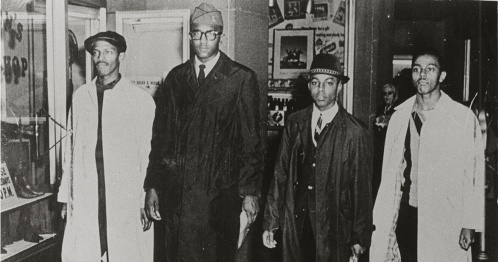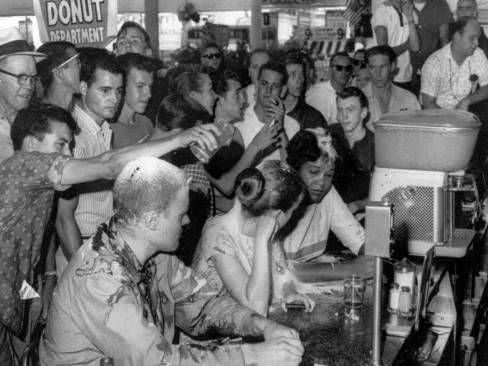The Greensboro Sit-Ins were non-violent protests in Greensboro, North Carolina, which started on February 1, 1960 when young African-American students staged a sit-in at a segregated Woolworth’s lunch counter and refused to leave after being denied service. The Greensboro Sit-Ins were the first prominent sit-ins of the civil rights movement.

GREENSBORO FOUR
The Greensboro Four were four young black men who staged the first sit-in at Greensboro: Ezell Blair Jr., David Richmond, Franklin McCain and Joseph McNeil. All four were students from North Carolina Agricultural and Technical College.

They were influenced by the non-violent protest techniques practiced by Mohandas Gandhi, as well as the Freedom Rides organized by the Congress for Racial Equality (CORE) in 1947, in which interracial activists rode across the South in buses to test a recent Supreme Court decision banning segregation in interstate bus travel.
SIT-IN BEGINS
Blair, Richmond, McCain and McNeil planned their protest carefully, and enlisted the help of a local white businessman, Ralph Johns, to put their plan into action.
On February 1, 1960, the four students sat down at the lunch counter at the Woolworth’s in downtown Greensboro, where the official policy was to refuse service to anyone but whites. Denied service, the four young men refused to give up their seats.

Police arrived on the scene, but were unable to take action due to the lack of provocation. By that time, Johns had already alerted the local media, who had arrived in full force to cover the events on television. The Greensboro Four stayed put until the store closed, then returned the next day with more students from local colleges.
SIT-INS SPREAD NATIONWIDE
By February 5, some 300 students had joined the protest at Woolworth’s, paralyzing the lunch counter and other local businesses. Heavy television coverage of the Greensboro sit-ins sparked a sit-in movement that spread quickly to college towns throughout the South and into the North, as young blacks and whites joined in various forms of peaceful protest against segregation in libraries, beaches, hotels and other establishments. By the end of March the movement had spread to 55 cities in 13 states.

The Greensboro Woolworth’s finally served blacks at its lunch counter on July 25, 1960, when manager Clarence Harris asked four black Woolworth’s employees—Geneva Tisdale, Susie Morrison, Anetha Jones, and Charles Best—to change out of their uniforms and into street clothes. The employees then ordered a meal at the lunch counter, becoming the first African Americans to be served at Woolworth’s. Most lunch counters around Greensboro would be desegregated over the next few weeks.
SNCC
The Greensboro Sit-Ins were the catalyst for the formation of Student Nonviolent Coordinating Committee (SNCC) which would become one of most important organizations of the Civil Rights Movement in the 1960s.
Over the next few years, SNCC served as one of the leading forces in the civil rights movement, organizing Freedom Rides through the South in 1961 and the historic March on Washington in 1963, at which Martin Luther King Jr. gave his seminal “I Have a Dream” speech.The International Civil Rights Center and Museum in Greensboro, North Carolina, has collections related to the Greensboro Sit-Ins.